Selection of the Bulbs
There are many flowering bulbs that may be encouraged to bloom indoors during the cold winter months. Some examples are: Paper whites or Daffodils (Narcissus), Amaryllis (Amaryllis), Iris (Iris), Tulips (Tulipa), Grape hyacinth (Muscari), Hyacinth (Hyacinthus), Crocus (Crocus)and Lily of the Valley (Convallaria majalis). Garden centers and catalogs often have cultivars that are specially bred for forcing. Only top-quality, good-sized bulbs should be used. Should different varieties be forced at the same time they may not bloom concurrently.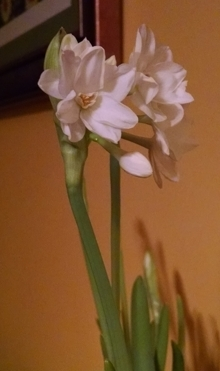
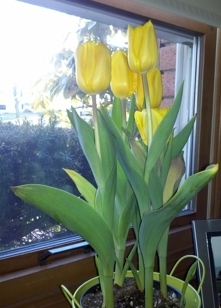
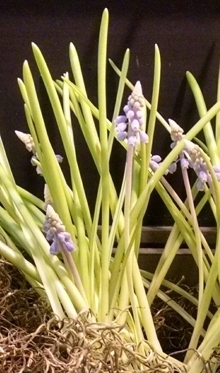
Potting
As with all container potting the container should be clean and sterilized. Clay, plastic, or glass may be used if it has adequate drainage. Unlike outdoor plantings, indoor forcing does not require as much space per bulb. In fact, the closer that the bulbs are placed the more esthetically pleasing the final product will be. A 6” diameter pot can hold 3 large bulbs (hyacinth), 5-6 medium bulbs (tulips or daffodils), or up to 15 small bulbs (crocus).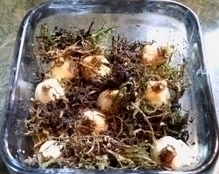
The bulbs can be potted in commercial potting soil, a mix of equal parts potting soil, sphagnum peat moss, and perlite. When potting in soil there should be at least 2” of soil beneath the lowest point of the bulb to allow for root growth. Tulips and daffodils can be left with the tips of bulbs showing above the surface but smaller bulbs such as crocus and grape hyacinth should be covered completely. Add water until it drips through the drainage hole.
Bulbs may be placed on pebbles or decorative stones if there is adequate depth to keep the bulbs from sitting in the water. Clear containers work well for this method so that the roots can be observed as the grow. The bulbs should be pressed into the pebbles ½ way up the bulb. Add water so that it covers the bottom 1/3 of the bulb (where the root hairs are showing).
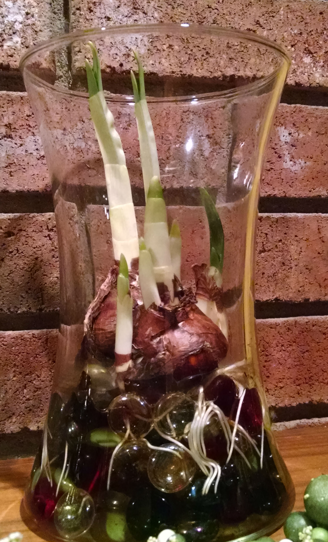
Cold period
Except for paper white narcissus all hardy bulbs must be exposed to temperatures between 35-50° F to prepare them for subsequent growth. The optimum cooling period is from 12-16 weeks. If the bulbs have been held in a refrigerator for any length of time prior to potting, then this should be subtracted from the total cooling period. Hyacinth, crocus, and narcissus bulbs can go through their cold period prior to being placed in the container and many narcissus bulbs do not require a cold period at all. The pots can be held anywhere that the temperature is in the 35-50° F zone such as an unheated garage, crawl space, or refrigerator.
Forcing
Bulbs that have been placed in a potting media can be moved to a cool but sunny location after the minimum 12 weeks of cold. A temperature of 50-60° F is preferable for the first week as the shoots and leaves begin to grow. It can then be moved to a warmer location out of direct sunlight. Most bulbs will bloom in three to four weeks.
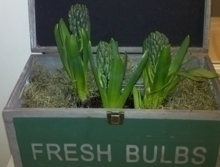
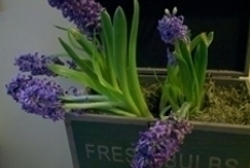
Once the roots appear in pebble containers the water level can be kept just at the base of the bulb. Keep the container in a cool, dark room for four to eight weeks until the root system has developed and the top elongates then place it in a sunny location.
After-bloom Care
Except for amaryllis most bulbs are spent once they have been forced and are not likely to rebloom. It may be possible to get them to bloom again if they are planted outdoors. This will require allowing the foliage to continue growing for if possible. A water-soluble fertilizer should be given once a week at ½ strength. After the foliage has naturally died back it can be removed and the bulbs can be planted in the garden or stored for later planting.
Amaryllis
An amaryllis bulb can be forced to bloom for many years. It generally does not need any special treatment in the way of a cold period before forcing. It should be potted in a container that is only 1-2” larger in diameter than the bulb. The upper half of the bulb should be exposed above the soil line. It should be watered thoroughly and then allowed to dry out completely. It should then receive water only when the soil is dry. Put the plant in a warm, sunny spot until the flower buds show color and then move it out of direct sunlight.
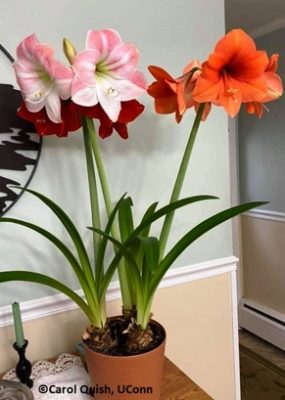
After bloom, remove any spent flowers to prevent seed formation. If the danger of frost has passed the pot may be placed outside in allocation that receives dappled sunlight, gradually moving it to an area where it will receive 5-6 hours of full sun each day. It can be fertilized with a balanced houseplant food diluted to ½ strength once a week.
The plant should be brought indoors prior to the first fall frost and placed in a dark location. As the leaves dry out it should not be watered for up to 8 weeks. After the rest period it should be treated like a newly potted bulb starting with a thorough watering. When new growth appears the upper two inches of soil should be removed and replaced with fresh soil. A new cycle will start and may be repeated for many years. If small plantlets appear beside the main bulb they may be gently separated from the mother bulb and repotted.
For pesticide information or other questions please call toll free: 877-486-6271.
UConn Home and Garden Education Center, 2017
Issued in furtherance of Cooperative Extension work, Acts of May 8 and June 30, 1914, in cooperation with the U.S. Department of Agriculture, the Dean of the College, Cooperative Extension System, University of Connecticut, Storrs. The Connecticut Cooperative Extension System is an equal opportunity employer and program provider. To file a complaint of discrimination, write USDA, Director, Office of Civil Rights, Room 326-W, Whitten Building, Stop Code 9410, 1400 Independence Avenue, SW, Washington, DC 20250-9410 or call (202) 720-5964.